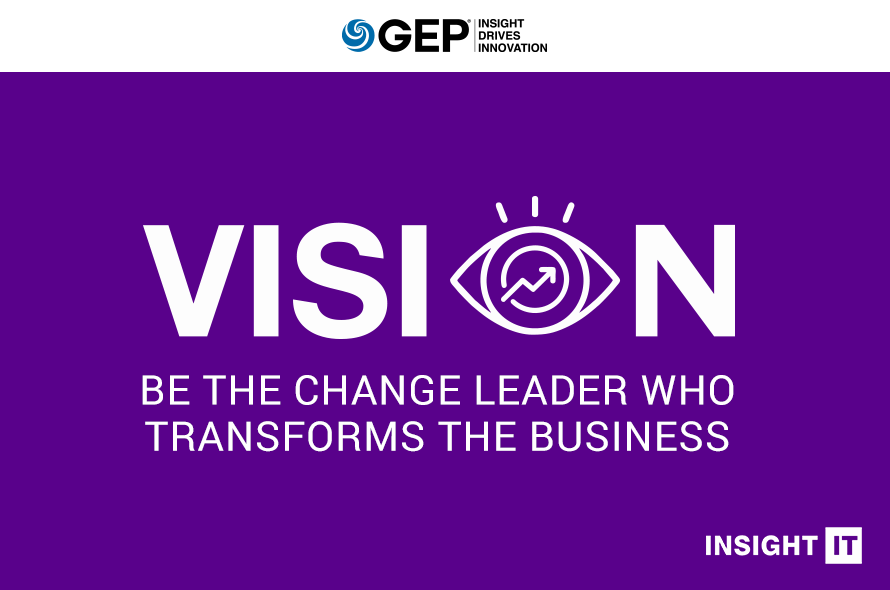If you’re in IT, then you know that your department — and maybe you personally — are on the receiving end of a lot of questions from other departments. Here’s a tip: If IT wants to be seen as a leader within the enterprise, then IT needs to be the function that asks the questions. Leaders ask questions — such as those that start with “How can we …” and “Why don’t we …” and “Don’t you think we should …”
In other words, leaders are endowed with vision that enables them to embrace the concept of change as something that makes growth and progress possible. How do you get to be a leader like that? What kind of attitude shift would be needed? And is the effort really worth it?
In our latest commentary from the INSIGHT IT series, VISION: Be the Change Leader Who Transforms the Business, we explore the potential for IT organizations to overcome attachment to the “known” and start spearheading the company’s pursuit of real competitive advantage.
Get your complimentary copy today, and start propelling transformation within your enterprise.
In our earlier INSIGHT IT article, Embrace the Future: The Case for Doing Things Differently, we encouraged CIOs and IT teams to adopt the habit of saying “yes” instead of “no” to requests by enterprise colleagues. And IT does get a lot of requests. Does this mean that IT is considered an influential function within the business? Well — yes and no.

All too often, it actually indicates that IT is too focused on the status quo — or worse: legacy technology — to serve as a driving force for change. This is an ever-greater concern if the questions IT is being asked are about topics they should have been the ones to introduce to the business.
In order to shift this paradigm and step into a leadership role, IT needs to get far enough ahead of the rest of the organization to be the ones asking the questions and setting the pace for others. When led by a visionary CIO, IT organizations should be persistently asking questions of the C-suite and other operational leaders, and pushing back against their instinct to say “no” in the face of change.
Rewriting Relevance
Enterprise IT has changed significantly since the advent of cloud computing. Many of the areas that used to dominate time — and budget — are no longer IT's direct responsibility. IT used to own software integration, hosting, security, databases, and servers. Handing off these responsibilities shouldn't leave IT with a feeling of loss. With integration being handled via Platform-as-a-Service, and hosting, databases, and server maintenance giving way to the “cloud,” IT is in a position to reinvent the role it will play in the organization from this point forward.
If IT is going to lead change and embrace the potential of the future, it must take calculated risks and educate itself. Getting ahead of, and being change's greatest advocate internally, requires a willingness to stay up to date on technologies that are not yet relevant, and may never be. Learning about a technology that is never implemented is still an investment in the future. The wider IT's funnel of knowledge, the greater the likelihood of pre-empting challenges and requests from elsewhere in the business.
CIO: Chief “Intrapreneurship” Officer
It is one thing to insist that IT should enthusiastically chart a course for the future. It is another thing entirely to honestly articulate the reasons it might want to do so. A CIO that wants to build, and that has the desire to lead and push the limits in pursuit of competitive advantage, should run IT with an entrepreneurial — or “intrapreneurial” — value set.
Despite the rate and impact of change seen today, IT must be prepared to accept and thrive in uncertain circumstances. Implementation timelines are shrinking, and distance to the planning horizon grows shorter every day. Just as IT will need to educate itself enough to learn about new technologies midstream, it will need to develop a level of comfort with making decisions in the absence of absolute certainty.
“Intrapreneurial” IT will also have different expectations, and generate very different results, from its relationships with solution providers. While a traditional relationship might be focused
on meeting SLAs and quietly supporting the status quo with minimal hands-on time, futuredriven IT leaders will want to find providers they can partner with to further what their organization, and therefore their enterprise, is capable of. This requires finding a provider that has technology designed on the premise that the future is a desirable place to reach, and that is led by a team of equally entrepreneurial business minds.
Once IT combines a healthy attitude toward risk with technology partners interested in advancing the journey, it will be ready to bring the rest of the enterprise into the effort. This is the point when IT reaches full leadership status — when it's helping other teams and functions acclimate to the coming change.
Filling the Negative Space
If the areas we've already discussed don't make IT's current challenges seem complex enough, keep in mind that all of them are focused on known business needs and challenges. Even with a forward-looking mindset, IT's thinking may be tied to legacy systems in ways it doesn't realize.

This thinking needs to change. IT needs to be able to step back and imagine the “negative space,” or the business needs around, across, and between the systems in place today. What unarticulated needs exist? Which new systems would most positively influence how the company performs in a digital environment? IT should not only be asking these questions; it should also be anticipating the business' needs, introducing new possibilities for leveraging technology as they arise — whether they have already been articulated or not.
It is impossible to be a leader while focusing on pre-existing platforms and long-enduring challenges. Constantly trying to fix broken things anchors IT to legacy technologies and approaches, and does little to indicate its leadership potential, especially if problems persist. Escaping this state will require IT to break the cycle of past decisions and stop tolerating less than ideal platform/interface performance and satisfaction.
Positive Outlook, Positive Outcomes
IT teams that are truly ready to embrace the future will also be impatient to reach it. This creates a dynamic where the promise of tomorrow pulls them forward with such strength that the familiarity of the past has no hold. Fear of the unknown — whether it plays out through altered relevance, discovery of emerging technologies, or an appetite for risk — has no place in planning for the future. Fortunately, a focus on a bright horizon can often serve as a counterweight to the short-term distractions and challenges that often impede progress.

